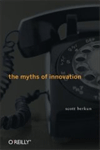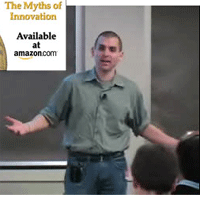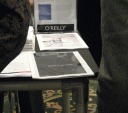Bay area book tour: report
Time: 3 days
Lectures: 8
Hotel rooms: 3
Total audience: ~360
Places visited: E-bay, Apple, Google, MobiTV, Book Passages, Adaptive Path, Adobe
Books sold: ~50
3am nights at the W hotel bar: 1
Total cost: ~$1000
The horror stories:
- At 1am at the Sir Francis drake hotel near Union Square, the room next door turns their TV on full blast. I call the desk and they send security. 10 minutes later I get a call: the people in the room are passed out and triple locked the door. They moved me up to the 12th floor.
- All technology went to hell in the San Francisco Adobe office, and a frazzled author didn’t start until nearly 15 minutes late. This was almost compensated for by how cool and competent the tech person in San Jose was.
The fun stories:
- Had great, fun crowds. About 100 people showed up at Google, 80 or so at MobiTV, and nearly 100 at Adaptive Path. People asked questions, bought books and laughed at my jokes: that’s the trifecta.
- Did my first bookstore reading. I’d resisted this on the following assumption: how can you make a reading not pretentious? I’ve been bored to tears at every reading I’ve ever been to. I kept it short and informal – read a few pages, answered some questions, nice and simple – it was a small venue w/12 chairs, but we filled 10 of them, and sold some books.
Lessons learned :
- Make a checklist. I’ve done 3 previous tours and I still always make stupid mistakes. This time it was postcards: I had free giveaway cards but forgot to put them out at a single venue.
- Timing. Not sure what the lesson is, but it seems impossible to time a book tour just right. Either you beat the reviews, or your come in behind them: does it matter? I still wonder if there’s a way to get more out of the timing of PR like this.
- PR creates PR. Neither my interview with Matt, nor my gig at MobiTV,would have happened if the tour wasn’t already scheduled. Every tour I’ve done has at least one good opportunity fall into place that wouldn’t have happened otherwise.
Thanks to:
- My tours are only possible because of people who host me and set things up at their places of work. Thanks to Rob Christensen, Sara Peyton, Ken Norton, Chad Thornton, Peter Merholz, Sarah B. Nelson, Shailesh Shilwant, Ray Ortigas, Pedraum Pardehpoosh, Bob Baxley and everyone who came out to say hi and listen.







 When a book is first off the presses it’s time for celebration – So to kick off the the release of my new book is this little shindig.
When a book is first off the presses it’s time for celebration – So to kick off the the release of my new book is this little shindig.
